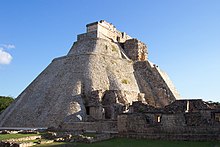Pyramid of the Magician
Waldeck's account of Uxmal inspired John Lloyd Stephens and his illustrator friend, Frederick Catherwood, to make two extended visits to the site in 1839–1841, to record and sketch the layout of the complex.
In the early 1970s, a major conservation project was undertaken by archaeologists from the National Institute of Anthropology and History (INAH - Instituto Nacional de Antropología e Historia).
The aim of this effort was to consolidate the sides and flat terraces of the pyramid, and to improve the structural integrity of the temples.
In 1988, Hurricane Gilbert swept across the Yucatán Peninsula, bringing high winds and abundant rainfall to the area which caused extensive damage to the exterior of the pyramid.
The plan called for the strengthening the West façade, monitoring of any structural changes, and implementing emergency measures where needed.
Conservation efforts are still underway and, as with El Castillo in Chichen Itza, visitors to the site are now prohibited from climbing the pyramid.
It is considered unique because of its rounded sides, considerable height, steep slope, and unusual elliptical base.
The Mayans followed the traditional practice of superimposition in the construction of the pyramid, gradually increasing the dimensions by building new structures on top of existing ones.
The passageway that led to this structure was closed off after the drenching rains of Hurricane Gilbert in 1988 in order to assure the preservation of the building.
Constructed in the Chenes style, the temple's façade represents the mask of Chaac, whose jaws serve as the door.
The earlier phases of the Pyramid of the Magician were constructed in the Puuc style: rather bare on the lower part and very ornate at higher levels.
Early Puuc architecture included roof crests, inclined friezes, and an absence of mosaic decoration.
Chenes design was prevalent in Late Classic Mayan construction, characterized by doorways surrounded by a single creature mask, with the entrance serving as the mouth.
Modern facilities can be now found at the entrance, immediately in front of the pyramid; including a cafeteria, souvenir shop, and restrooms.
According to one account, a magician-god named Itzamna was single-handedly supposed to have erected the pyramid in one night, using his might and magic.
Another tale holds that when a certain gong was to sound, the city of Uxmal was destined to be led by a boy “not born of woman”.
The ruler reconsidered the death sentence, though, and promised that the dwarf's life would be spared if he could perform three seemingly impossible tasks.
A slightly different version of this tale is recounted by Hans Li in The Ancient Ones: Legend tells that this temple-pyramid was built by a powerful dwarf magician, who was hatched from an egg by his mother.
In other surviving versions, the old woman is portrayed as a witch or sorceress and the dwarf is a boy who magically reaches adulthood overnight.
Who built it, why it was located away from water or any of those natural advantages which have determined the sites of cities whose histories are known, what led to its abandonment and destruction, no man can tell."

